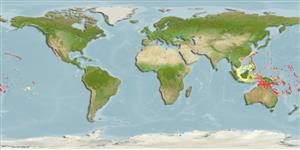>
Acanthuriformes (Surgeonfishes) >
Acanthuridae (Surgeonfishes, tangs, unicornfishes) > Acanthurinae
Etymology: Ctenochaetus: Greek, kteis, ktenos = comb + Greek, chaite = hair (Ref. 45335).
More on author: Randall.
Environment: milieu / climate zone / depth range / distribution range
Ecología
marino asociado a arrecife; rango de profundidad 0 - 61 m (Ref. 58302), usually 5 - 40 m (Ref. 27115). Tropical; 28°N - 26°S
Distribución
Países | Áreas FAO | Ecosistemas | Ocurrencias, apariciones | Point map | Introducciones | Faunafri
Pacific Ocean: throughout most Oceania, from Micronesia, Wake and Marcus islands to the Hawaiian Islands and Pitcairn Island.
Tamaño / Peso / Age
Maturity: Lm ? range ? - ? cm
Max length : 25.0 cm TL macho / no sexado; (Ref. 9710)
Espinas dorsales (total): 8; Radios blandos dorsales (total): 27-29; Espinas anales 3; Radios blandos anales: 25 - 26. Gill rakers on anterior row 21-25, on posterior row 25. Juveniles differ greatly from adults. They have deeper bodies and are bright orange-red with numerous dark chevrons. Adults appear uniformly black from a distance but actually have numerous dark green horizontal pinstripes.
An uncommon species that inhabits seaward rocky or coral reefs (Ref. 9710). Juveniles found in relatively deep coral rich areas (Ref. 42056). Benthopelagic (Ref. 58302). Feeds on film algae (Ref. 89972). Minimum depth reported taken from Ref. 128797.
Life cycle and mating behavior
Madurez | Reproducción | Puesta | Huevos | Fecundidad | Larva
Randall, J.E and K.D. Clements, 2001. Second revision of the surgeonfish genus Ctenochaetus (Perciformes: Acanthuridae), with descriptions of two new species. Indo-Pac. Fish. (32):33 p. (Ref. 42056)
IUCN Red List Status (Ref. 130435)
Threat to humans
Harmless
Human uses
Acuario: Comercial
Más información
Nombres comunesSinónimosMetabolismoDespredadoresEcotoxicologíaReproducciónMadurezPuestaAgregación para la puestaFecundidadHuevosEgg development
ReferenciasAcuiculturaPerfil de acuiculturaRazasGenéticaElectrophoresesheritabilidadEnfermedadesProcesamientoNutrientsMass conversion
ColaboradoresImágenesStamps, Coins Misc.SonidosCiguateraVelocidadTipo de nataciónSuperficie branquialOtolitosCerebrosVisión
Herramientas
Special reports
Download XML
Fuentes de Internet
Estimates based on models
Preferred temperature (Ref.
123201): 24.9 - 29, mean 27.8 °C (based on 534 cells).
Phylogenetic diversity index (Ref.
82804): PD
50 = 0.5020 [Uniqueness, from 0.5 = low to 2.0 = high].
Bayesian length-weight: a=0.02344 (0.01098 - 0.05004), b=2.97 (2.80 - 3.14), in cm total length, based on LWR estimates for this (Sub)family-body shape (Ref.
93245).
Nivel trófico (Ref.
69278): 2.0 ±0.00 se; based on food items.
Resiliencia (Ref.
120179): Alto, población duplicada en un tiempo mínimo inferior a 15 meses (Preliminary K or Fecundity.).
Fishing Vulnerability (Ref.
59153): Low vulnerability (15 of 100).
Nutrients (Ref.
124155): Calcium = 31.1 [19.0, 51.8] mg/100g; Iron = 0.236 [0.126, 0.567] mg/100g; Protein = 18.1 [16.8, 19.3] %; Omega3 = 0.128 [0.082, 0.203] g/100g; Selenium = 22.9 [13.2, 41.6] μg/100g; VitaminA = 43.7 [10.0, 177.3] μg/100g; Zinc = 0.369 [0.273, 1.260] mg/100g (wet weight);
